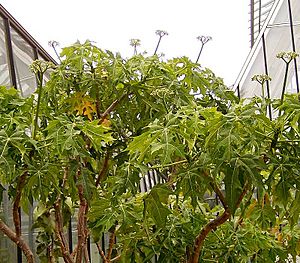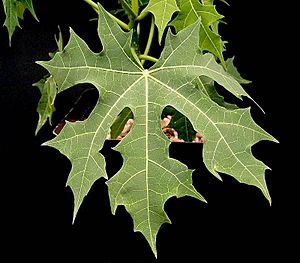Chaya facts for kids
Quick facts for kids Chaya |
|
|---|---|
 |
|
| ‘Estrella’ | |
| Scientific classification | |
| Genus: |
Cnidoscolus
|
| Species: |
aconitifolius
|
| Subspecies | |
|
C. aconitifolius subsp. aconitifolius |
|
| Synonyms | |
|
Cnidoscolus chayamansa McVaugh Cnidoscolus chaya Lundell Cnidoscolus fragrans (Kunth) Pohl Cnidoscolus longipedunculatus (Brandegee) Pax & K.Hoffm. Cnidoscolus napifolius (Desr.) Pohl Cnidoscolus palmatus (Willd.) Pohl Cnidoscolus quinquelobatus (Mill.) León Jatropha deutziiflora Croizat Jatropha fragrans Kunth Jatropha longipedunculata Brandegee Jatropha napifolia Desr. Jatropha palmata Sessé & Moc. Ex Cerv. Jatropha papaya Medik. Jatropha quinqueloba Sessé Jatropha quinquelobata Mill. |
|
Cnidoscolus aconitifolius, often called chaya, tree spinach, or spinach tree, is a large, fast-growing leafy plant. It is a perennial shrub, meaning it lives for many years. People believe it first grew in the Yucatán Peninsula of Mexico.
The scientific name, aconitifolius, means "Aconitum-like leaves." This refers to its leaf shape. Chaya plants have juicy stems that release a milky liquid if you cut them.
This plant can grow up to 6 metres (20 ft) (about 20 feet) tall. However, farmers usually trim it to about 2 metres (6.6 ft) (6.5 feet) to make harvesting the leaves easier. Chaya is a popular leaf vegetable in Mexican and Central American cooking. It is used much like regular spinach. The plant also grows white flowers on a tall stem above its leaves.
It is very important to cook chaya leaves before eating them. Raw leaves contain a natural acid that can be harmful. You can safely eat up to five raw leaves a day, but cooking is always best. To be safe, cook the leaves for 5 to 15 minutes. Many recipes suggest cooking them for 20 minutes. Also, never cook chaya in aluminum pots, as this can make it unsafe to eat.
Contents
Growing Chaya Plants
Chaya is quite easy to grow and usually does not get much damage from insects. It can grow well in places like Florida, even if it's a tender perennial. The plant can handle heavy rain and can also survive some dry periods.
How to Plant Chaya
Most people grow chaya from cuttings of its woody stems. These cuttings are usually 6 to 12 inches long. It is rare for chaya plants to produce seeds.
When you first plant chaya cuttings, they grow slowly because their roots take time to develop. Because of this, you should not harvest any leaves during the first year. After that, you can pick chaya leaves regularly. Just make sure not to remove more than half of the leaves from the plant. This helps the plant stay healthy and grow new leaves.
Chaya's Amazing Yield
A study by the USDA in Puerto Rico found that chaya produced more green vegetables than any other plant they studied. Another study showed that chaya leaves have many more nutrients than spinach leaves. The white flowers on chaya plants also attract beautiful butterflies.
Eating Chaya Safely
Some types of chaya have tiny stinging hairs on their leaves. If you are picking these varieties, it is a good idea to wear gloves. Cooking the leaves destroys these stinging hairs, making them safe to handle and eat. Cooking also removes the natural harmful substances found in the raw plant. Chaya is one of the most productive green vegetables you can grow.
Nutritional Benefits
Chaya is a great source of protein, vitamins, calcium, and iron. It also has many antioxidants, which are good for your body. However, remember that raw chaya leaves contain a substance that can release harmful cyanide. This is why cooking is so important. Cooking helps to get rid of these harmful parts. Chaya is similar to cassava, another plant that must be cooked before eating due to similar natural substances.
It is important to avoid cooking chaya in aluminum pots. This can create a harmful liquid that might cause diarrhea.
How to Prepare Chaya
Young chaya leaves and the soft tips of the stems are cut and boiled like spinach. It is a tasty vegetable and is very rich in protein, calcium, iron, and vitamin A. In fact, chaya leaves have two to three times more nutrients than most other leafy green vegetables grown on land. Some studies even suggest that chaya leaves might help with diabetes.
Traditionally, people boil chaya leaves for 20 minutes. After cooking, they are often served with oil or butter. Boiling for 20 minutes or more makes the leaves completely safe to eat. The liquid left after cooking the leaves can also be safe to drink. This is because the harmful cyanide turns into a gas (hydrogen cyanide) and escapes during the cooking process.
Types of Chaya Plants
There are four well-known types, or cultivars, of chaya: ‘Picuda’, ‘Estrella’, ‘Chayamansa’, and ‘Redonda’. The ‘Estrella’, ‘Redonda’, and ‘Chayamansa’ types cannot produce seeds or fruit because their pollen is not strong enough. However, the ‘Picuda’ type and some others can produce seeds.
These popular types of chaya do not have many urticating hairs (stinging hairs) compared to other wild chaya plants. This is why they are used more often in cooking.
See also
 In Spanish: Cnidoscolus aconitifolius para niños
In Spanish: Cnidoscolus aconitifolius para niños


